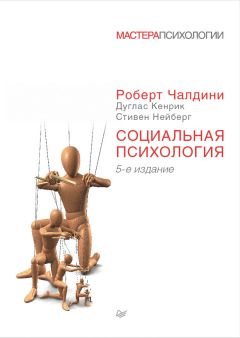Филип Зимбарго - Социальное влияние
Smart, R. C, and Feger, D. (1974). The effects of high and low fear messages about drugs. Journal of Drug Education, 4, 225–235. Smith, M., Bruner, J., and White, R. (1956). Opinions and personality. New York: Wiley.
Snyder, M. (1979). Self — monitoring processes. In L. Berkowitz (Ed.), Advances in experimental social psychology (vol. 12, pp. 85–128). New York: Academic Press.
Snyder, M., and Cunningham, M. R. (1975). To comply or not to comply: Testing the self — perception explanation of the «foot — in — the — door» phenomenon. Journal of Personality and Social Psychology, 31, 64–67.
Snyder, M., and DeBono, K. G. (1985). Appeals to image and claims about quality: Understanding the psychology of advertising. Journal of Personality and Social Psychology, 49, 586–597.
Snyder, M., and Debono, K. G. (1987). A functional approach to attitudes and persuasion. In M. P. Zanna, J. M. Olson, and С. Р. Herman (Eds.), Social influence: The Ontario symposium (vol. 5, pp. 107–128). Hillsdale, NJ: Erlbaum.
Snyder, M., and Swann, W.B.Jr. (1978). Hypothesis — testing processes in social interaction. Journal of Personality and Social Psychology, 36, 1202–1212.
Snyder, M., and Uranowitz.S. W. (1978). Reconstructing the past: Some cognitive consequences of person perception. Journal of Personality and Social Psychology, 36, 941–950.
Sorrentino.R.M., Bobocel, D. R., Gitta, M.Z., Olson, J. M., and Hewitt, E. С (1988). Uncertainty orientation and persuasion: Individual differences in the effects of personal relevance on social judgments. Journal of Personality and Social Psychology, 55, 357–371.
Spelke,E., Hirst, W., and Neisser.U. (1976). Skills of divided attention. Cognition, 4, 215–230.
Staats,A. W., and Staats, С. К. (1958). Attitudes established by classical conditioning. Journal of Abnormal and Social Psychology, 37–40.
Stasser, G., Kerr, N. L., and Bray, R. M. (1982). The social psychology of jury deliberations: Structure, process, and products. In N. L. Kerr and R. M. Bray (Eds.), The psychology of the courtroom (pp. 221–256). New York: Academic Press.
Stasser, G., Kerr, N. L., and Davis, J. H. (1989). Influence processes and consensus models in decision — making groups. In P. B. Paulus (Ed.), Psychology of group influence (2d ed., pp. 279–326). Hillsdale, NJ: Eribaum.
Steele, С. М. (1988). The psychology of self — affirmation: Sustaining the integrity of the self. In L. Berkowitz (Ed.), Advances in experimental social psychology (vol. 21, pp. 261–302). New York: Academic Press.
Steele, С Al, Southwick, L. L., and Critchlow, B. (1981). Dissonance and alcohol: Drinking your troubles away. Journal of Personality and Social Psychology, 41,831–846.
Stein, J. A., Newcomb, M. D., and Bentler, P. M. (1987). An 8–year study of multiple influences on drug use and drug consequences. Journal of Personality and Social Psychology, 53, 1094–1105.
Stephan, W. G., and Rosenfield, D. (1978). Effects of school desegregation on racial attitudes. Journal of Personality and Social Psychology, 36, 795–804.
Stoner.J.A. (1961). A comparison of individual and group decisions involving risk. Unpublished master's thesis. School of Industrial Management, Massachusetts Institute of Technology.
Strodtbeck.F.L., and Hook, L. H. (1961). The social dimensions of a twelve — man jury table. Sociometry, 24, 397–415.
Strodtbeck, F. L., James, R. M., and Hawkins. D. (1957). Social status in jury deliberations
American Sociological Review, 22, 713–7)9.
Sue, S., Smith, R. E., and Caldwell, C. (1973). Effects of inadmissible evidence on the decisions of simulated jurors: A moral dilemma. Journal of Applied Social Psychology, 3, 345–353.
Sullivan Report to Congress (1990).
Surgeon General (1983). The health consequences of smoking: Cardiovascular disease: A report of the Surgeon General. DHHS Publication No. PHS 84–50204. Rockville, MD: Office of Smoking and Health.
Swann, W.B., Jr. (1983). Self — verification: Bringing social reality into harmony with the self. In J. Suls and A. G. Greenwald (Eds.), Social psychological perspectives on the self (vol. 2, pp. 33–66). Hillsdale, NJ: Erlbaum.
Swann, W. В., Jr., and Ely, R. J. (1984). A battle of wills: Self — verification versus behavioral confirmation. Journal of Personality and Social Psychology, 46, 1287–1302.
Swann, W. В., Jr., Pelham,B.W., and Chidester,T.R. (1988). Change through paradox: Using self — verification to alter beliefs. Journal of Personality and Social Psychology, 54,268–273.
Sweeney, P. D., and Gruber, K. I. (1984). Selective exposure: Voter information preferences and the Watergate affair. Journal of Personality and Social Psychology, 46, 1208–1221.
Taylor, S., E. (1986). Health psychology. New York: Random House.
Taylor, S. £., and Fiske, S. T. (1975). Point of view and perceptions of causality. Journal of Personality and Social Psychology, 32, 439–445.
Tedeschi, J. Т., and Rosenjeld, P. (1981). Impression management theory and the forced compliance situation. In J. T. Tedeschi (Ed.), Impression management theory and social psychological research. New York: Academic Press.
Tedeschi, J. Т., Schlenker, B. R., and Bonoma, T. V. (1971). Cognitive dissonance: Private ratiocination or public spectacle. American Psychologist, 26, 685–695.
Tesser,A. (1978). Self — generated attitude change. In L. Berkowitz (Ed.), Advances in experimental social psychology (vol. 11). New York: Academic Press.
Tesser, A, and Conlee,M. C. (1975). Some effects of time and thought on attitude polarization. Journal of Personality and Social Psychology, 31,262–270.
Tetlock, P. E. (1983). Accountability and complexity of thought. Journal of Personality and Social Psychology, 45, 74–83.
Tetlock, P. E., and Kim, J. 1. (1987). Accountability and judgment processes in a personality prediction task. Journal of Personality and Social Psychology, 52, 700–709.
Tetlock, P. E., Skitka, L., and Boettger, R. (1989). Social and cognitive strategies for coping with accountability: Conformity, complexity, and bolstering, Journal of Personality and Social Psychology, 57, 632–640.
Thibaut,]., and Walker, L. (1975). Procedural justice: A psychological analysis. Hillsdale, NJ: Erlbaum. Time (1979). Secret voices: Messages that manipulate. Sept. 10,71.
Tindale, R. S., Vollrath, D. A., Davis, J. H., Nagao, D. H., and Hinsz, V. B. (1990). Asymmetric social influence in freely interacting groups. A test of three models. Journal of Personality and Social Psychology, 58, 438–449.
Traub, J. (1988). Into the mouths of babes. The New York Times Magazine, July 24, 18–20, 37–38, 52–53.
Troyer, R. J., and Markle, G. E. (1983). Cigarettes: The battle over smoking. New Brunswick, NJ: Rutgers University Press.
Tulving, E. (1983). Elements of episodic memory. Oxford: Clarendon Press.
Turtle, J. W., and Wells, G. I. (1988). Children versus adults as eyewitnesses: Whose testimony holds up under cross — examination? In Grune — berg et al. (Eds.), Practical aspects of memory. London: Wiley.
Tversky,A., and Kahneman, D. (1974). Judgment under uncertainty: Heuristics and biases. Science, 185, 1124–1131.
Tversky, A., and Kahneman, D. (1986). Rational choice and the framing of decisions: Journal of Business, 59, S251–S278.
Varela, J. A. (1971). Psychological solutions to social problems: An introduction to social technology. New York: Academic Press.
Vidmar,N., and Laird, N.M. (1983). Adversary social roles: Their effects on witnesses' communication of evidence and the assessments of adjudicators. Journal of Personality and Social Psychology, 44, 888–898.
Visher, С A. (1987). Juror decision making: The importance of evidence. Law and Human Behavior, 11, 1–17.
Walster, E., and Festinger, L. (1962). The effectiveness of «overheard» persuasive communications. Journal of Abnormal and Social Psychology, 65, 395–402.
The Washington Post (1990). Feb. 17.
Watson, D. (1982). The actor and the observer: How are their perceptions of causality different. Psychological Bulletin, 92, 682–700.
Watts, W. A. (1967). Relative persistence of opinion change induced by active compared to passive participation. Journal of Personality and Social Psychology, 5, 4–15.
Weinsteln, N. D. (1982). Unrealistic optimism about susceptibility to health problems. Journal of Behavioral Medicine, 5, 441–460.
Weinstein, N. D., and Lachendro, E. (1982). Ego — centrism as a source of unrealistic optimism. Personality and Social Psychology Bulletin, 8, 195–200.
Weir, W. (1984). Another look at subliminal «facts» Advertising Age, 46, October 15.
Weiss, W., and Steenbock, S. (1965). The influence on communication effectiveness of explicitly urging action and policy consequences. Journal of Experimental Social Psychology, 1, 396–406.
Wells, G. L. (1980). Asymmetric attributions for compliance: Reward versus punishment. Journal of Experimental Social Psychology, 16, 47–60.
Wells, G. L., Ferguson, T. J., and Lindsay, R. С L. (1981). The tractability of eyewitness confidence and its implications for triers of fact. Journal of Applied Psychology, 66, 688–696.
Wells, G.L., and Leippe, M. R. (1981). How do triers of fact infer the accuracy of eyewitness identification? Using memory for detail can be misleading. Journal of Applied Psychology, 66, 682–687.
Wells, G. L., Leippe, M.R., and Ostrom,T.M. (1979). Guidelines for empirically assessing the fairness of a lineup. Law and Human Behavior, 3, 285–293.
Wells, G. L., Lindsay, R. С L., and Ferguson, T. J. (1979). Accuracy, confidence, and juror perceptions in eyewitness identification. Journal of Applied Psychology, 64, 440–448.
Wells, G. L., and Murray, D. M. (1984). Eyewitness confidence. In G. L. Wells and E. F. Loftus (Eds.), Eyewitness testimony: Psychological perspectives. New York: Cambridge University Press.
Wells, G. L., and Petty, R. E. (1980). The effects of overt head movements on persuasion: Compatibility and incompatibility of responses. Basic and Applied Social Psychology, 1, 219–230.
Wells, G. L., Wrightsman, L. S., and Miene, P. K. (1985). The timing of the defense opening statement: Don't wait until the evidence is in. Journal of Applied Social Psychology, 15, 758–772.
Wilson, T. D.., Dunn, D. S., Kraft, D., and Lisle, D. J. (1989). Introspection, attitude change, and attitude — behavior consistency: The disruptive effects of explaining why we feel the way we do. In L. Berkowitz (Ed.), Advances in experimental social psychology (vol. 22, pp. 287–343). New York: Academic Press.
Wilson, T. D., and Linville, P. W. (1982). Improving the academic performance of college freshmen: Attribution therapy revisited. Journal of Personality and Social Psychology, 42, 367–376.
Wilson, W., and Miller, H. (1968). Repetition, order of presentation, and timing of arguments and measures as determinants of opinion change. Journal of Personality and Social Psychology, 9, 184–188.
Winett, R. A., Kagel, J. H., Battalia, R. C, and Winkler, R.. С. (1978). Effects of monetary rebates, feedback, and information on residential electricity conservation. Journal of Applied Psychology, 65, 73–80.
Winett, R. A., Neale, M. S., and Grier, H..С. (1979). Effects of self — monitoring and feedback on residential electricity consumption. Journal of Applied Behavior Analysis, 12, 173–184.
Wolf, S., and Montgomery, D. A. (1977). Effects of inadmissible evidence and level of judicial admonishment. Journal of Applied Social Psychology 7,205–219.
Wood, W. (1982). Retrieval of attitude relevant information from memory: Effects on susceptibility to persuasion and on intrinsic motivation. Journal of Personality and Social Psychology, 42, 798–810.
Wood, W., Kallgren,C.A., and Priesler, R. M. (1985). Access to attitude — relevant information in memory as a determinant of persuasion: The role of message attributes. Journal of Experimental Social Psychology, 21, 73–85.
Wood, W., Wong,F. K, and Сhachere J. 0.(1990). Effects of media violence on viewers' aggression in unconstrained social interaction. Psychological Bulletin, in press.
Wrightsman, L. S. (1987). Psychology and the legal system. Monterey, CA: Brooks/ Cole.
Wu, C, and Shaffer, D. R. (1987). Susceptibility to persuasive appeals as a function of source credibility and prior experience with attitude object. Journal of Personality and Social Psychology, 52, 677–688.
Yates, S. M., and Aronson, E. (1983). A social psychological perspective on energy conservation in residential buildings. American Psychologist, 38, 435–444.




